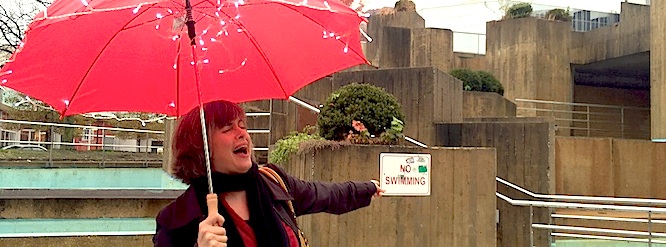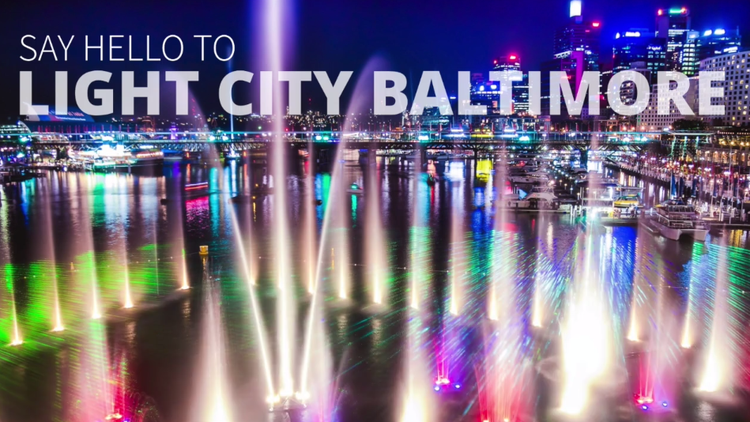Demolition of McKeldin Fountain, a public work of art at the center of Baltimore’s newest public art festival, seems like a bad idea by Cara Ober
Although official plans have not yet been approved by the City of Baltimore, Light City performers were informed by BOPA in early December that the McKeldin Fountain area will be off limits because of its impending demolition. This may seem shocking to those who are still campaigning for preservation of the historic structure, but for Baltimore’s performance art collective Fluid Movement, it’s par for the course.
The popular Baltimore-based performance group whose annual water ballets attract an audience of 3500+ each summer has been trying to enact a site-specific McKeldin Fountain performance for over a year.

According to Fluid Movement Co-Founder and Board President Valarie Perez-Schere, acting director since 2012, “Member Amanda Dice pitched this idea years ago, to do a performance about McKeldin Fountain at the fountain. She did research, site visits, and we planned a public pop up performance at the site, all for no charge to the city. However, we couldn’t get through the different city agencies to make it work, to get the necessary permissions.”
Perez-Schere described the dysfunctional process her group encountered, early in 2015, where they reached out multiple times to the Downtown Partnership, the Waterfront Partnership, Baltimore Rec & Parks, and the Mayor’s Office—and found no agency able or willing to give them permission to do the free performance, even after they applied for a Rec and Park permit via the Mayor’s Office.

For anyone who has ever tried to pull a permit in Baltimore City, this inconvenient and unproductive cycle is no surprise, but, in the case of McKeldin Fountain, a historic structure located in the heart of Baltimore’s Inner Harbor, it raises questions of benign inefficiency vs. purposeful neglect on the part of these agencies.
Baltimore’s Downtown Partnership, a non-profit organization of business leaders whose goal is to bring economic development and foot traffic to the Inner Harbor has been campaigning for the demolition of the fountain for over a decade, in order to create a more unified and updated Inner Harbor. Knowing this, is it surprising that such a powerful group would be unable to approve a highly popular and free art performance to the area it purports to service?
“We found a huge circle of beaurocracy,” says Perez-Shere, of the experience. “It became obvious that no city agency was in charge of making decisions about McKeldin Plaza. We found a large team of unrelated partners and we were never able to make the performance a reality. We had the show developed but had to tank it because it became a waste of time and money.”

This all changed when Fluid Movement saw the call for Baltimore’s new Light City festival scheduled for March, 2016. Intended for Baltimore’s Inner Harbor, where McKeldin Fountain sits at the center, the group pitched their proposal again—and this time it was accepted. “We thought it was a perfect fit,” says Perez-Schere. “Light City will take care of the permits! We applied and got approved and were thrilled.”
“We proposed three plans,” says Perez-Schere, based on their past experiences and research on the location. “We had one plan for the fountain if there was water in it, another without water, and a third if we could not perform on or in the fountain at all, but in front of it. In the past we had been told by various Baltimore agencies that no water will ever go back into the fountain, only to find it filled up the next week, so we knew we needed to be prepared for any scenario.”
What the group did not expect was that their approved McKeldin-themed site-specific performance, celebrating the history of the Baltimore ‘worker’ with original song and dance routines for each of the four decades the fountain has existed, would be moved to another location entirely.

“We were told that our site-specific performance about McKeldin Fountain will not be able to be performed at McKeldin Fountain because it will be blocked off by construction fencing, so we reworked our performance, creating a new version of it not within sight of the fountain,” explains Perez-Schere.
Instead of their original plans, Fluid Movement has designed a mini moveable ‘Stonehenge-like structure’ that resembles the Brutalist Fountain, made out of corrugated plastic prisms. “The performance is about work, being in a place of business where all walks of life come together,” says Perez-Schere. “This fountain and sculpture inspired us, and relates to the idea of working and the worker. At this point it will probably be easier to do this in an amphitheater space, even though the performance is still all about the fountain.”
While it is still unclear whether the skywalks connected to the fountains will be under demolition as planned, or the whole fountain itself, or nothing at all, the timing of the intended demolition couldn’t be worse for Light City, Baltimore’s new international festival of art and technology whose goal is to celebrate “ideas, ingenuity and creativity through art, music and innovation.”

Light City, sponsored by Baltimore’s Office of Promotion and the Arts, who politely declined to respond to questions about the timing of the demolition of McKeldin Fountain during the 5 million dollar event, states in PR materials that their core values are tied to those of Baltimore City: “Innovation, Collaboration, Sustainability, and Transformation.” These values may seem bitterly ironic, considering the lack of such values in Fluid Movement’s past attempts at programming in the area as well as public calls for an open and democratic process concerning the future of the fountain.
I reached out to Kirby Fowler, Director of the Downtown Partnership leading the calls for demolition of McKeldin Fountain, in conjunction with the Mayor’s Office, for clarification about the timing of the demolition in conjunction with Light City, to whom I give credit for being willing to answer my questions.
Fowler explained, “We are big supporters of Light City, both in terms of our participation on multiple committees and our financial contribution of $40,000 for its inaugural year. Since the idea was first brought to our attention, we have encouraged organizers to consider locating installations throughout Downtown and the City and not simply along the Inner Harbor Promenade. We also let BOPA and festival organizers know that demolition of the skywalks connected to the fountain could begin before Light City and that the fountain should not be considered for festival installations. We did offer to fence/screen any demolition area, and we confirmed that the bulk of McKeldin Plaza could be available for an installation.”
According to Fowler, Baltimore’s Public Arts Commission has never indicated that the fountain was considered protected public art and their meeting minutes reflect this fact.
However, Jeremy Rountree, a current member of Baltimore’s Public Arts Commission disagrees with Fowler’s statement. Rountree says, “The Baltimore City Public Arts Commission voted, back in December of 2014, that the public art inventory maintained by the city was correct in listing the McKeldin Fountain as a work of art. The evidence reviewed overwhelmingly supported that conclusion. At that time, we also requested that demolition be postponed until justification had been presented, the rational questioned, and the matter having been submitted for a vote in accord with our deacessioning policy. We approved those meeting minutes in April or May of 2015.”

So far, there has been no official public announcement of the approval for the Downtown Partnership’s plan, but Fowler explained that the demolition and construction phasing was put together long before Light City was a reality. On the possible detriment of the intended demolition, Fowler said, “We will absolutely work with BOPA so that any demolition will not adversely affect the festival which, aside from Light City University, will occur once the sun is down and after any demolition would have ceased for the day.”
Although Fowler is confident that the problems created by demolition would be minimal, its location in the center of a public art festival seems unsightly and inconvenient during an event seen as a new opportunity for many city residents and visitors to experience Baltimore’s Inner Harbor in a positive way. In addition, the destruction of the beloved public fountain which is still hotly contested, in terms of it being a public work of art funded by voter referendum in the 1980’s and one of few remaining Brutalist structures, without an approved plan or full funding for the new and improved McKeldin Plaza seems unnecessarily rushed at best. When asked about the timing Fowler responded that, “If major construction was held up every time there is Downtown event, no new projects would ever be realized. “
Either way, the show will go on and Light City participants, including Fluid Movement, are excited for their projects to be realized in and around Baltimore’s Inner Harbor.

“We love the fountain and see our piece as a homage to McKeldin,” says Perez-Schere, of the upcoming performance. “We’re not necessarily doing a protest piece, but we are going to keep up hope that they can find a good solution for everyone, that we can all come together and agree on a way to preserve this historical structure… Maybe it could involve altering the space, keeping some of the fountain, or moving it. I wish that everyone could pull together to create a common goal that works for the people of Baltimore.”
On Fluid Movement’s upcoming participation in Light City, Perez-Schere said, “We want this festival, and this part of town, to be a success. Nobody wants this place to be a mess, blocked up in the center for construction when it is totally unnecessary. This is a visual public art event and it needs to look good. Why would you shoot yourself in the foot like that?”
Author Cara Ober is Founding Editor at BmoreArt
HydroPrismEchoChamber: Fluid Movement’s Ode to McKeldin Fountain in Light City, the no longer site-specific performance, is scheduled for Tuesday March 29 at 6:30, 8:30, and 10:30 and Saturday April 2, 6:30 and 8:30.






